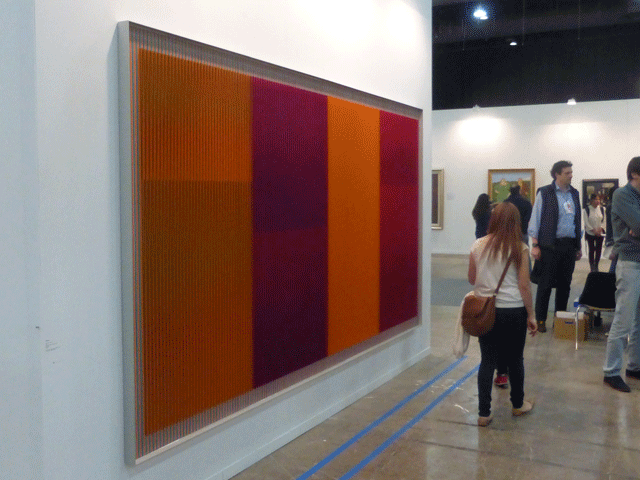
Cruz-Diez “Physichromie Panam 216,” 2015. At Galeria Cayon.
Last week, I visited Mexico City’s Zona MACO (México Arte Contemporaneo), Latin America’s largest art fair. This was on the heels of our visit to Material, a satellite fair that impressed Paddy and me beyond our expectations. Walking into MACO felt just like visiting the most art fair-y of art fairs by comparison—which is to say, the immediate experience was predictable. There were long convention center lines, groups of “fresas” queuing up to take selfies in reflective sculptures, and familiar overexposed blue-chip names such as Alex Katz and Richard Prince. (“Fresas” is Mexican slang for “yuppies”, literally translating to “strawberries”.) MACO devoted a good chunk of floor space to design wares—from furniture to high-end sunglasses. I wasn’t immediately inspired to lend the event much thought beyond snapping some photos. With a few days of reflection, I realize Zona MACO is noteworthy for its extremes. And that’s not just the quality or quantity of blatantly commercial crap. For all the lackluster blue chip staples on the floor, I also saw an impressive amount of well-curated project booths that smartly positioned emerging artists and galleries in dialogue with the establishment. These two poles served a useful purpose: they lay bare how contemporary art fairs function. Zona MACO is the best model I can think of to demonstrate how for-profit fairs must work to remain both commercially viable (see above GIF) and discursively relevant. For better or for worse, MACO excels at both.
Perhaps because of the peso’s affordable exchange rate with other currencies, there seemed to be more ambitious presentations than we’re used to seeing at most U.S. fairs. Tellingly, Latin American galleries took the limelight here. Two generous sections of curated booths offered work on par with Material in terms of feeling fresh and artist-centric. Zona MACO Sur, curated by João Mourão and Luis Silva, featured galleries with solo projects. While New Proposals, curated by Humberto Moro, focused on remarkably solid group shows from emerging galleries. Gallerists seemed eager to discuss artworks with earnest passion—never feeling like a sales pitch. That’s rare. Another rare takeaway: days after attending, I find myself thinking about individual artists and their work rather than dealers and sales.
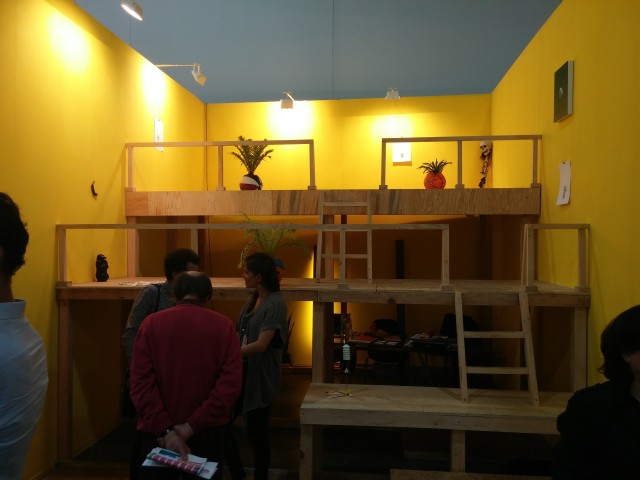
Anonymous Gallery (of DF) had the most creative solution to an art fair booth floorspace shortage. Scattered around the lofts were planters made from sports balls, kitschy figurines, and small drawings. It was conceptualized as a tree house, and all the small works somehow referenced bananas. Featuring Alex Becerra, Andrew Birk, Chris Bradley, Radamés “Juni” Figueroa, Henry Gunderson, Jeanette Hayes, Sadie Laska, and Eric Munoz

Bjorn Melhus’s 3-walls-full of self-portraits at New York’s Y Gallery.
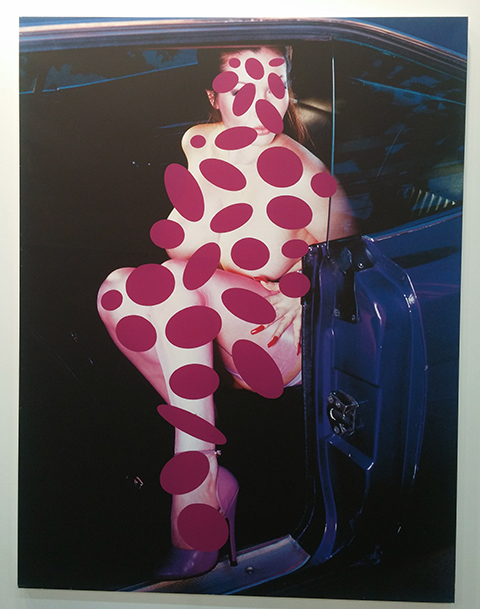
A Richard Prince that I actually like! “Untitled (Oh)” 2010, at Gagosian. I couldn’t figure out why I liked this beyond the fact that it’s pretty. Paddy pointed out that the dots begin to look like clothing in an expression of “false modesty.”
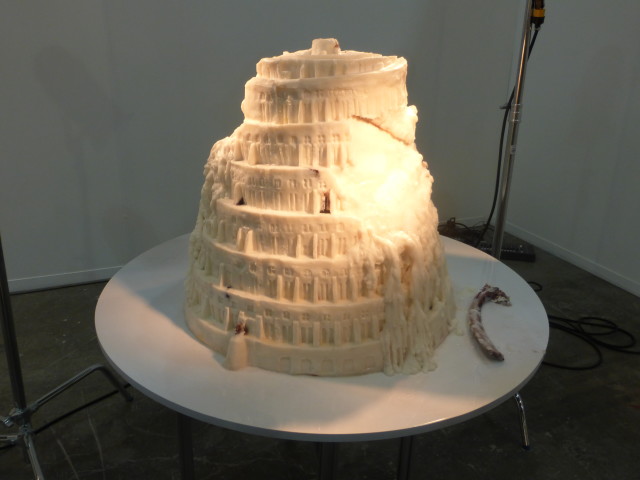
Raúl Ortega Ayala, “Babel Fat Tower,” is a model based on Pieter Brueghel’s 1563 painting “The Tower of Babel” made from animal fat and bones. It’s sitting under bright spotlights and slowly melting. Of all the sensationalist work at Zona MACO, this is by far the grossest artwork in the room. At Mexico City’s Proyectos Monclova.
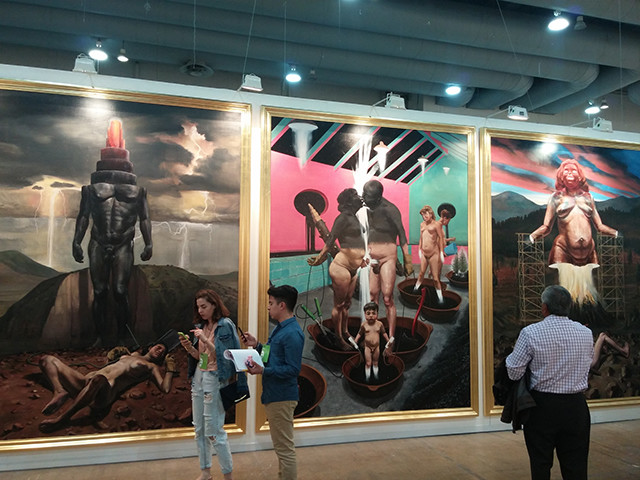
Daniel Lezama, “Conductores,” 2016 at Mexico City’s Galería Hilario Galguera. These contemporary, larger-than-life oil paintings are just so classically Mexican Surrealist. You can’t tell from the photo, but the first thing everyone I was with noticed was that every male figure in the panels has a massive erection.

At Mexico City’s Parque Galería, Spanish troublemaker Santiago Sierra and local Yoshua Okón collaborated on this disco toilet. The only other thing in the booth is a poster of “The Thinking Man” sitting on it. At first, I wasn’t sure what the message here was, but apparently the bowl is modeled on the Museo Soumaya, an art museum founded by the wife of controversial Mexican billionaire Carlos Slim.
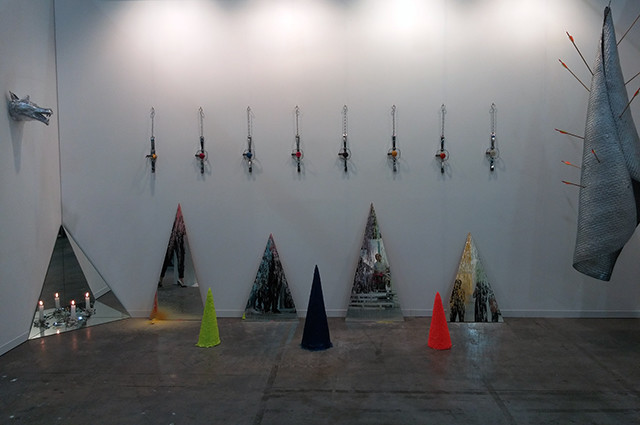
Morelos León Celis at Galería Luis Adelantado (México DF and Valencia). This strangely hypnotic installation with melting candles, mirror, and other ritualistic ephemera seemed to magnetically draw crowds, and kept me in the booth. I didn’t want to leave. Is this showmanship how all religion started?
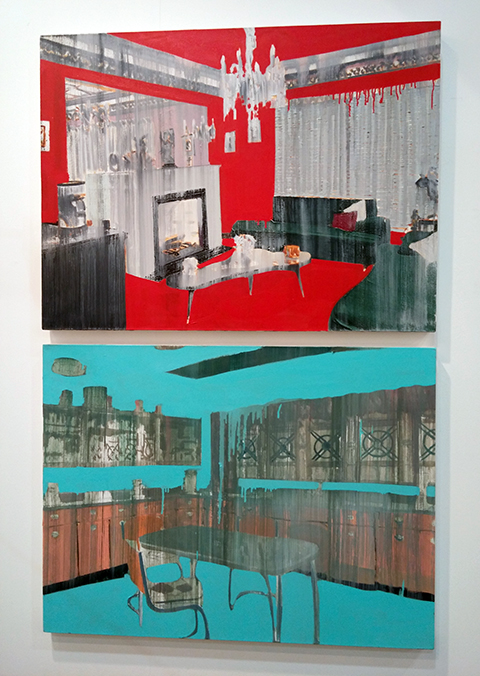
At YAM Gallery (San Miguel de Allende, Mexico) these paintings by Javier Areán depict the artist’s beloved childhood home. I was told the house used to host many Mexican artists and travelers when it was in the family’s possession. The artist made these paintings based on recently-discovered old photographs and hazy memories—it’s not quite clear if the image is coming into focus or being forgotten. The series reminds me a bit of the Genieve Figgis pieces we saw at NADA New York. In both series, there’s an interior from a romanticized era where the viewer gets the sense all is not right.
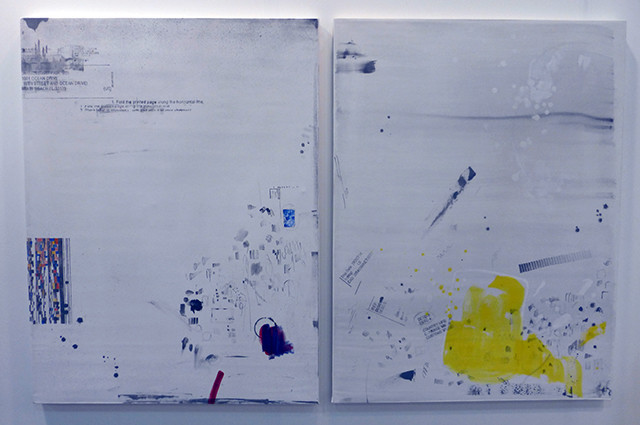
Ana Bidart, “Pasaporte: fold” and “Untitled (ensayo de pasaporte),” 2016 at Josée Bienvenu Gallery. Even in the fair’s uncurated general section, a handful of booths read as solid group shows sensitive to context. These paintings from Uruguay-born, DF-based Ana Bidart show what appears to be a United States guest visa worked into a disorienting abstract composition. The visa lists the address of the Untitled art fair in Miami Beach. Given the difficulties Latin American artists face entering and working in the US (and the increasingly hostile border rhetoric), it’s a timely piece for an art fair in Mexico.
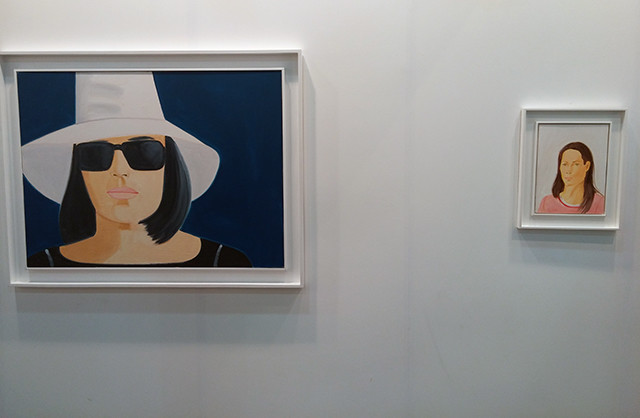
Madrid’s Galeria Javier Lopez packed—who else?—Alex Katz for the art fair. Sometimes I see so much Alex Katz work at fairs, I picture dealers keeping him locked up in a sweatshop to churn out paintings like Apple does iPhones.

Eugenio Ampudia, “Dónde Dormir” (Where to Sleep), 2008-2014. Max Estrella showed documentation of Eugenio Ampudia sleeping in famous landmarks, such as DF’s Museo Anahuacalli (a museum designed by Diego Rivera in a neo-Aztec style). These are huge prints, with a wall-sized video accompanied by copious amounts of text. You can’t tell from this dramatic image, but some of the museum interiors looked like a fun camp-out. I like that ambiguous relationship between the playfulness of the gesture and the monumentality of the settings. A bit of that absurdity gets lost with how precious the presentation feels.
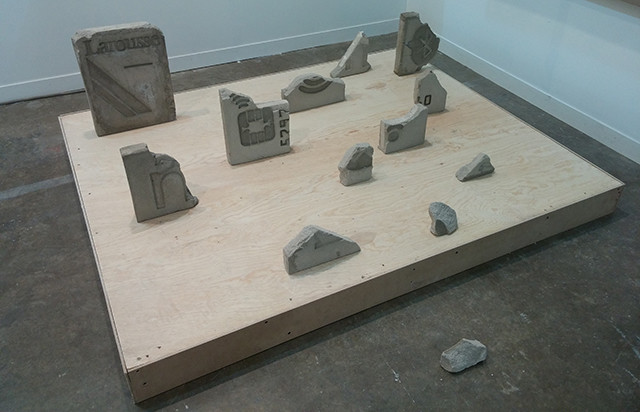
Panamanian gallery DiabloRosso had another great booth, smartly curated around a Rem Koolhaas quote: “We live in a very flat digital world in which everything is accessible but increasingly there is less and less memory. We are, you might say, condemned to the perpetual present.” These sculptures by Ignacio Gatica reproduce cigarette packaging, RFID chips, and other 21st century detritus as fossilized archaeological finds.
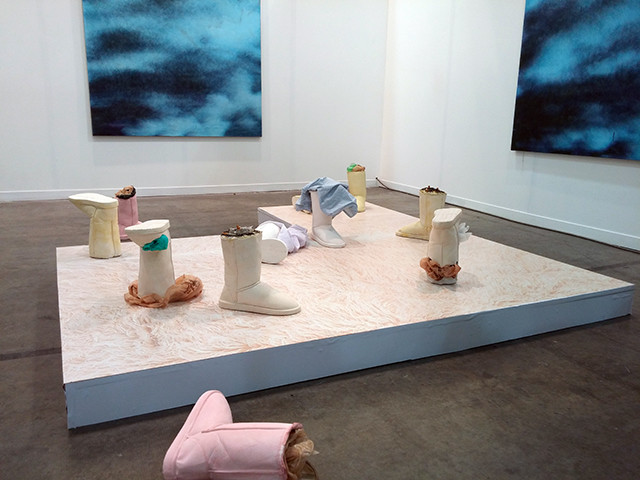
In the same row and spirit, a presentation by the gallery DUVE Berlin set Debora Delmar Corp’s casts of UGG Boots filled with trash against stormy paintings by Ivan Comas. It’s a dystopian nightmare, like the surface of Earth in “The Matrix” if all that survived of humanity was our worst fashion choices.
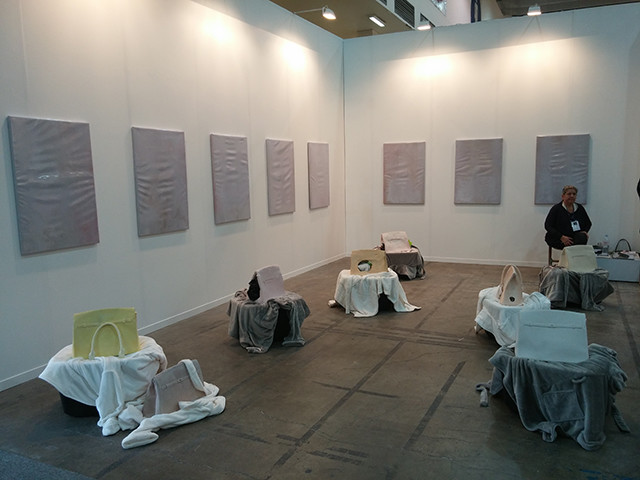
The Debora Delmar Corp made another, solo appearance at LTD Los Angeles’s booth. These purses are ceramics, I believe, glazed to almost look like they are made of cake. A conflation of objects of desire? These, coupled with the unevenly-stretched canvases in a neutral background color, read differently in the presence of design booths hawking fare like sunglasses; they seem to suggest commodity consumption has taken the foreground in the world of fine art.

The series “Bloom in Rot” by Javier Palacios at Espai Tactel (Valencia, Spain). These paintings are almost so fun that I didn’t want to love them as much as I did. Palacios perfectly captures the essence of 1980s pulp-pop; looking at these is like watching a David Cronenberg film while reading a comic book and listening to The Misfits. With titles such as “Dr Muerte” (left) and subject matter such as cinematic explosions, the series was easily some of the least-stuffy stuff in the fair.
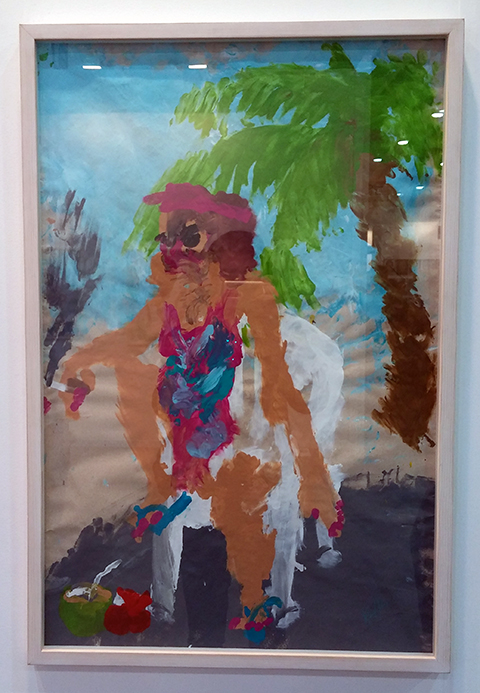
Mexico City’s Galería Karen Huber completely stole the show with a solo exhibition by Manuel Solano—an artist who works in neon, painting, and video/performance with a tragicomic relationship to pop culture as collective mythology. In 2014, Manuel Solano went blind from complications related to HIV and began making these paintings. It’s incredible that the painter is able to produce these with the sense of touch—conveying a sense of movement while still retaining legibility. They’re visceral and great and never seem without a sense of humor. They remind me a bit of Dynasty Handbag—both aesthetically and in the use of warped pop aesthetics to illustrate a personal queer narrative.
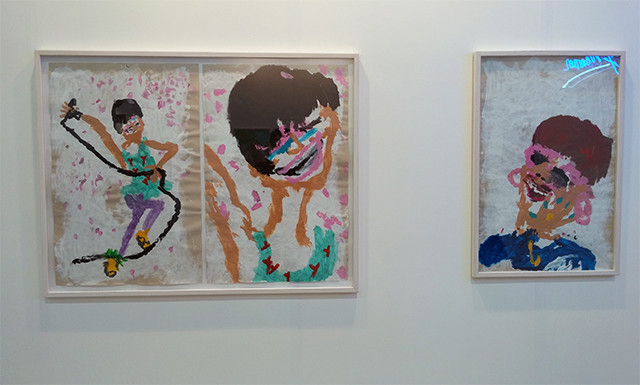
Manuel Solano
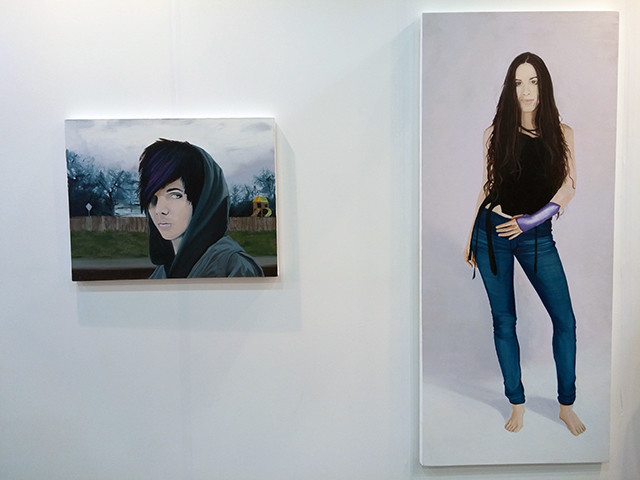
These recent paintings were produced in collaboration with Tlahuac Mata, who Solano describes as “my prosthetic eyes”. The work seems to capture the illustration-like qualities, obsessiveness, and attention to detail of fan art. They’re equal parts clinically perfectionist and passionate—like Orthodox icon paintings painstakingly reproduced.
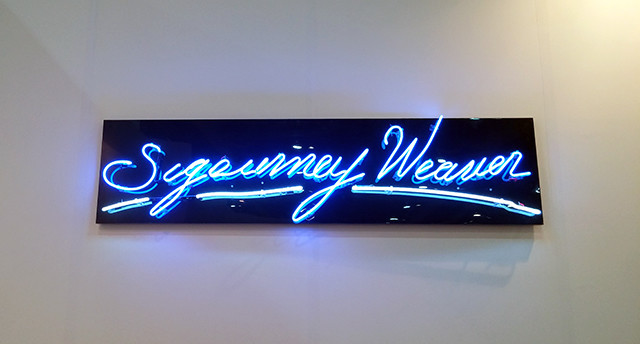
Manuel Solano’s “Sigourney Weaver” neon. A few feet away is a video of Solano recreating Sinéad O’Connor’s infamous “Fight the Real Enemy” performance on SNL. I read this as a citation of strong female pop icons associated with “survival” or “defiance” as a kind of shorthand—similar to how classical artists would have used an allusion to Artemis or Cassandra (totally the Sinéad O’Connor of ancient Greece) as a metaphor for a complex conflict in their work.


Comments on this entry are closed.
{ 1 trackback }